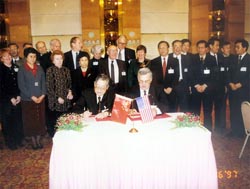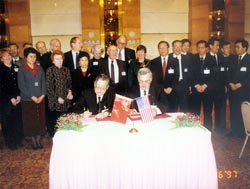

The picture shows an agreement for co-hosting such a symposium is signed by leaders of the two sides in 1997.
October 2007 witnessed the convention of the 10th session of the Chinese-American Kavli Frontiers of Science Symposium in Beijing. Over the past 10 years, the forum has greatly contributed to the S&T exchanges and cooperation between the two countries.
At a high-level meeting between the US National Academy of Sciences (NAS) and the Chinese Academy of Sciences (CAS) held in January 1997 in Beijing, leaders of the two sides reached a consensus on co-hosting a Chinese-American Frontier of Sciences Symposium so as to bolster exchange and cooperation between young scientists of the two countries.
The first session of the symposium was held in August 1998 at the Beckman Center in Irvine, California. The Chinese delegation, which was headed by Prof. BAI Chunli, vice president of CAS, included about 40 members from research institutes and universities of China. The session consisted of eight topic teams on cosmogony, biological recognition, crystal growth, El Nino phenomena, brain imaging, genetic diseases, uni-atomic physics and chemistry, and the origin of life.
During the past decade, a total of 10 symposia have been held, bringing together more than 670 young scientists from some 300 institutions of the two countries. They made explorative discussions on 77 research frontier topics of modern science.
Participants bring expertise and ideas from diverse scientific backgrounds to the symposia, which are designed to promote cross-disciplinary discussion and generate new ideas. Each symposium is organized around eight topics, jointly selected by a committee of CAS and NAS delegates, and based largely on feedback from the previous year's meeting. Session chairs and speakers highlight the major challenges, methodologies, and limitations in their fields without using technical jargon to ensure that non-specialists are able to understand and contribute to the meeting. Speakers and participants pose and field challenging questions that probe into and across traditional boundaries of research disciplines.
These symposia stand out as an important example of the promotion of interactions and cooperation among scientists on both the international and the domestic level, asserts an article co-authored by CAS Executive Vice President BAI Chunli Bai, and Deputy Director General of the CAS Bureau of International Cooperation CAO Jinghua , which was published in a recent issue of the
Proceedings of the National Academy of Sciences (PNAS).
"The diversity of the symposium programs reflects the complexity of leading-edge science and illustrates that major scientific discoveries require crossing traditional disciplinary boundaries. If this approach was foreign to many Chinese scientists a decade ago, it is not anymore. Chinese scientists attending recent symposia are more actively engaged in the question-and answer sessions than before, demonstrate higher level presentation skills, and are more confident about having equal footing in exchanges with U.S. scientists. This development mirrors the progression of science in China and the emergence of a new generation of internationally oriented Chinese scientists," they added.
The academic linkages, mutual understanding, and mutual respect developed among scientists of the two countries should have a wide impact on scientific exchange and collaboration between the two scientific communities and should advance their shared interests in discovery at the frontiers of science, stressed the authors.








